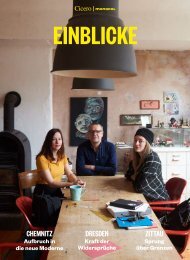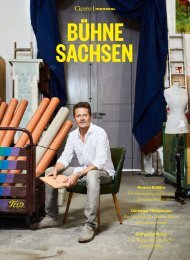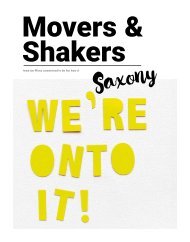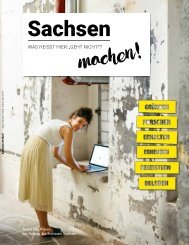The future is made in saxony
A magazine of the Free State of Saxony Autumn/Winter 2014
A magazine of the Free State of Saxony Autumn/Winter 2014
You also want an ePaper? Increase the reach of your titles
YUMPU automatically turns print PDFs into web optimized ePapers that Google loves.
Anglo-Saxon<br />
From Saxony to Hamburg and the United States – and then back to<br />
Saxony: Hans J. Naumann has had a lively career <strong>in</strong> bus<strong>in</strong>ess.<br />
Naumann: Indeed. In 1970, my family and I packed our bags <strong>in</strong> the<br />
United States. I took over the company <strong>in</strong> Germany and restructured<br />
it. With<strong>in</strong> 10 years, I had <strong>in</strong>creased sales 14-fold to DM 140 million.<br />
In the 1970s, you were a successful entrepreneur <strong>in</strong> West<br />
Germany and a firm fixture <strong>in</strong> German <strong>in</strong>dustry. And yet you<br />
turned your back on your country once aga<strong>in</strong>. Why was that?<br />
Naumann: My children, who were born <strong>in</strong> the United States, desperately<br />
wanted to study there. In addition, the American company<br />
SIMMONS, which I knew from earlier on, was up for sale.<br />
SIMMONS was the successor to the US company NILES, which<br />
also had a German d<strong>is</strong>tributor <strong>in</strong> Berl<strong>in</strong> and later <strong>in</strong> Chemnitz, although<br />
I didn’t know that at the time. In 1982, I bought SIMMONS<br />
and focussed the company’s operations entirely on rail products.<br />
cooperation between bus<strong>in</strong>ess, academia and the state government,<br />
which works extremely well. <strong>The</strong> universities of applied science and<br />
the Fraunhofer <strong>in</strong>stitutes sat<strong>is</strong>fy all our needs, while the Saxon Development<br />
Bank (SAB) has f<strong>in</strong>anced many new mach<strong>in</strong>e concepts.<br />
I guess that means you don’t really need to leave Saxony<br />
any more.<br />
Naumann: We also have production sites <strong>in</strong> the United States,<br />
Russia, South Africa, Ch<strong>in</strong>a and even Australia, not to mention sales<br />
and service companies. A company our size needs to have a global<br />
orientation as well as be active where our customers are and <strong>in</strong> a range<br />
of markets. Nevertheless, all our <strong>in</strong>novation activities will cont<strong>in</strong>ue to<br />
be <strong>in</strong>itiated from Saxony because the conditions here are perfect.<br />
Nonetheless, you now do not live <strong>in</strong> the United States or western<br />
Germany, but <strong>in</strong> Saxony. When and why did you return to your<br />
home region?<br />
Naumann: I’ve always been passionate about technical developments.<br />
Unfortunately, I couldn’t take advantage of th<strong>is</strong> passion<br />
because General Electric <strong>in</strong> Schenectady always snapped up the<br />
good eng<strong>in</strong>eers. Establ<strong>is</strong>h<strong>in</strong>g closer ties to the German mach<strong>in</strong>e-tool<br />
<strong>in</strong>dustry was the solution. Of course, reunification played <strong>in</strong>to my<br />
hands. In 1990, I v<strong>is</strong>ited the NILES subsidiary <strong>in</strong> Berl<strong>in</strong> as well as<br />
the d<strong>is</strong>tributor <strong>in</strong> Chemnitz, a former state hold<strong>in</strong>g company I had<br />
stumbled across by accident at a trade fair <strong>in</strong> Par<strong>is</strong>. In its f<strong>in</strong>al days,<br />
the East German leadership had built a new factory <strong>in</strong> Chemnitz.<br />
<strong>The</strong>y even had a good workforce. From then on, I couldn’t get the<br />
bus<strong>in</strong>ess out of my m<strong>in</strong>d. So I contacted the Berl<strong>in</strong>-based trustee responsible<br />
for privat<strong>is</strong><strong>in</strong>g former East German enterpr<strong>is</strong>es, negotiated<br />
with them and eventually bought the company <strong>in</strong> Chemnitz <strong>in</strong> 1992.<br />
Th<strong>is</strong> reunited the American and German parts of NILES. To quote<br />
former German Chancellor Willy Brandt: “What belonged together<br />
grew together.”<br />
Saxony, the United States, Europe: Hans J. Naumann has turned Niles-Simons-Hegenscheidt <strong>in</strong>to an <strong>in</strong>ternational company.<br />
In 2001, you even moved the group’s headquarters from the<br />
United States to Chemnitz. That was an unusual move.<br />
Naumann: HEGENSCHEIDT <strong>in</strong> Erkelenz was up for sale aga<strong>in</strong><br />
<strong>in</strong> 2001. I bought the company that I knew <strong>in</strong>side-out, br<strong>in</strong>g<strong>in</strong>g together<br />
American and German rail <strong>in</strong>dustry mach<strong>in</strong>e-tool manufacturers.<br />
I wanted the headquarters of th<strong>is</strong> new corporate group to be <strong>in</strong><br />
Chemnitz because the city had always been a centre of the German<br />
mechanical-eng<strong>in</strong>eer<strong>in</strong>g <strong>in</strong>dustry. You can still clearly feel that here<br />
today. From a psychological perspective, I also wanted to be a role<br />
model for the people <strong>in</strong> the region and send the message: “We’re not<br />
a company controlled from somewhere else.” That’s why we have<br />
our headquarters <strong>in</strong> Chemnitz.<br />
Hans J. Naumann: Milestones <strong>in</strong> h<strong>is</strong> life<br />
1966: First entrepreneurial activity as founder and partner of<br />
HEGENSCHEIDT Corp. <strong>in</strong> Detroit.<br />
1970: Returns to Germany as a partner <strong>in</strong> and manag<strong>in</strong>g director<br />
of HEGENSCHEIDT GmbH <strong>in</strong> Erkelenz.<br />
1982: Returns to the United States, where he takes over SIMMONS<br />
Corp, successor to the American company NILES <strong>in</strong> Albany.<br />
You were born <strong>in</strong> Dewitz near Leipzig and grew up <strong>in</strong> Zschorna<br />
manor near Wurzen. Today your office <strong>is</strong> <strong>in</strong> Chemnitz. It looks like<br />
you never managed to leave home.<br />
Naumann: Your summary overlooks important stages of my life.<br />
After our home was conf<strong>is</strong>cated and we were <strong>in</strong>terned on the <strong>is</strong>land of<br />
Rügen after World War II, my family moved to Hamburg, where I earned<br />
a degree <strong>in</strong> mechanical eng<strong>in</strong>eer<strong>in</strong>g <strong>in</strong> 1960. But I wanted to start my<br />
career <strong>in</strong> the United States. At FARREL, I worked my way up to<br />
technical director of the transm<strong>is</strong>sion department. Th<strong>is</strong> showed me<br />
that money was <strong>made</strong> <strong>in</strong> management. Hav<strong>in</strong>g by then picked up an<br />
MBA from Rochester University, I started my own bus<strong>in</strong>ess <strong>in</strong> Detroit,<br />
Michigan, <strong>in</strong> 1966. <strong>The</strong>re I built mach<strong>in</strong>es for the American market on<br />
behalf of German companies. One of these companies was HEGEN-<br />
SCHEIDT, based <strong>in</strong> Erkelenz <strong>in</strong> the Rh<strong>in</strong>eland. A new technology –<br />
deep roll<strong>in</strong>g, which prevented car stub axles from break<strong>in</strong>g – brought<br />
me my first orders from Pontiac and Ford. That was my first big success.<br />
You were so successful <strong>in</strong> the United States that the then<br />
owner of HEGENSCHEIDT <strong>in</strong> Germany wanted to appo<strong>in</strong>t you h<strong>is</strong><br />
successor. Th<strong>is</strong> <strong>is</strong> why you returned home, right?<br />
Today, almost 500 people work for the company <strong>in</strong> Chemnitz<br />
alone. You have <strong>in</strong>vested <strong>in</strong> new production halls and build<strong>in</strong>gs.<br />
What do you particularly appreciate about Chemnitz and the Free<br />
State of Saxony?<br />
Naumann: Political leaders play a key role <strong>in</strong> promot<strong>in</strong>g bus<strong>in</strong>ess.<br />
Kurt Biedenkopf, the Free State’s first premier, helped me buy the<br />
company from the trustee. We travelled to Japan and the United<br />
States together. Th<strong>is</strong> tradition was cont<strong>in</strong>ued by State Premiers<br />
Georg Milbradt and Stan<strong>is</strong>law Tillich. I often went to Russia with<br />
Tillich. <strong>The</strong>se trips were always <strong>in</strong> our shared <strong>in</strong>terest, and my<br />
relations with Saxony have always been very good. I also value the<br />
1992: Takes over NILES Drehmasch<strong>in</strong>en <strong>in</strong> Chemnitz. Comb<strong>in</strong>es<br />
the company with NILES’s American roots.<br />
2001: Takes over HEGENSCHEIDT and moves the headquarters<br />
of the new NILES-SIMMONS-HEGENSCHEIDT Group from the<br />
United States to Chemnitz.<br />
2013: Exactly 180 years after NILES was founded, the group has<br />
1,300 employees and 80 tra<strong>in</strong>ees and generates consolidated sales of<br />
more than EUR 310 million.<br />
12 <strong>The</strong> <strong>future</strong> <strong>is</strong> <strong>made</strong> <strong>in</strong> Saxony <strong>The</strong> <strong>future</strong> <strong>is</strong> <strong>made</strong> <strong>in</strong> Saxony 13

















